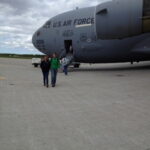I have been a general aviation pilot since 2010, and I fly a single engine aircraft on a regular basis. But what most people who know me don’t realize is that I used to be deathly afraid of flying.
Having worked in sales for much of my career, it was a necessary evil that I would have to take frequent commercial flights around the country to attend trade-shows. I am ashamed to admit that there was a time when I could not walk across the jet way and board my flight without first giving myself a dose of “liquid courage.” Even on the earliest of morning flights, I would self-medicate with a screwdriver or two to take the edge off before boarding the airplane.
The fear of flying is not uncommon. Most people are not familiar with the principles of aerodynamics and cannot wrap their minds around a huge piece of machinery weighing several tons is somehow able to become airborne and stay aloft during the duration of the journey. It just doesn’t seem natural.
Also, often without warning, these big beasts start bumping and bouncing around the sky deeming it necessary for the captain to make that announcement warning us of our immanent doom by telling us that we should immediately sit down and fasten our seatbelts low and tight.
Turbulence can be very unnerving and was a big fear of mine. I remember while flying through rough air the feeling of dread that would come over me as I would sit and wait for the wings to snap off the airplane and send us plummeting to the ground below.
How on Earth did I become a pilot then? How did I overcome these fears? The answer is simple: education. Just a small amount of understanding of the basic principals of flight can go a long way to squelch the fear of air travel.
For instance, do you know that in the event of a complete engine failure, an airplane will keep on flying? Yes, really. It does not just fall out of the sky as some people assume. It essentially becomes a glider at that point. Depending on the type of aircraft, the altitude, airspeed, pitch, etc., the glide range can be considerable, sometimes approaching 100 miles or more.
What about those nasty bumps? Think of it this way, the flow of winds aloft is much like the flow of water. Picture yourself in a boat moving down a river. The water is not always smooth. Sometimes it can become quite choppy and toss the boat around. This is much the same as an airplane moving through the air. The air can be smooth as glass, or it can be turbulent causing the aircraft to bump and bounce around just like the boat moving through the choppy water. It is a completely normal phenomenon.
Airplanes are structurally very strong and are made to withstand high-stress situations. Normal turbulence is no danger to an aircraft. Rest assured, the pilot is not sitting in the cockpit, brow furrowed; sweating, struggling to keep the airplane upright. To pilots turbulence is little more then a nuisance and perhaps irritation over a little spilled coffee.
How about when the plane enters the clouds? How does the pilot keep from crashing in to other aircraft or mountains? Take a deep breath. The vessel you are riding in is under constant Air Traffic Control observation. The controllers keep your aircraft and others a safe distance apart. There are also back up systems in place, including traffic and obstacle avoidance systems installed on the aircraft itself.
There are numerous books available that were written specifically to help people overcome the fear of flying. If your fear is extreme, check out Flying Without Fear by Duane Brown, PH.D.
Arm yourself with a little understanding of the basics of aviation and you will be able to finally sit back, relax and enjoy the flight.






